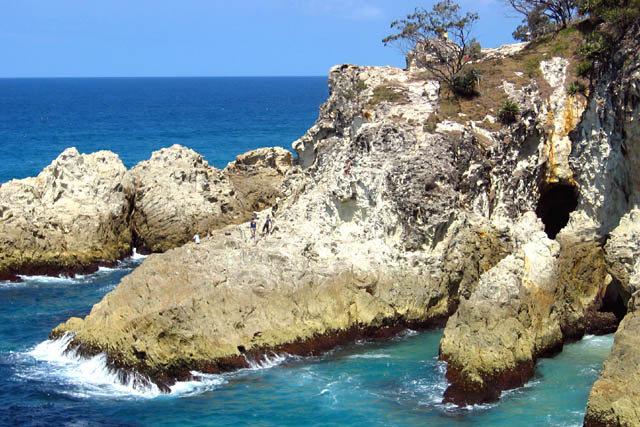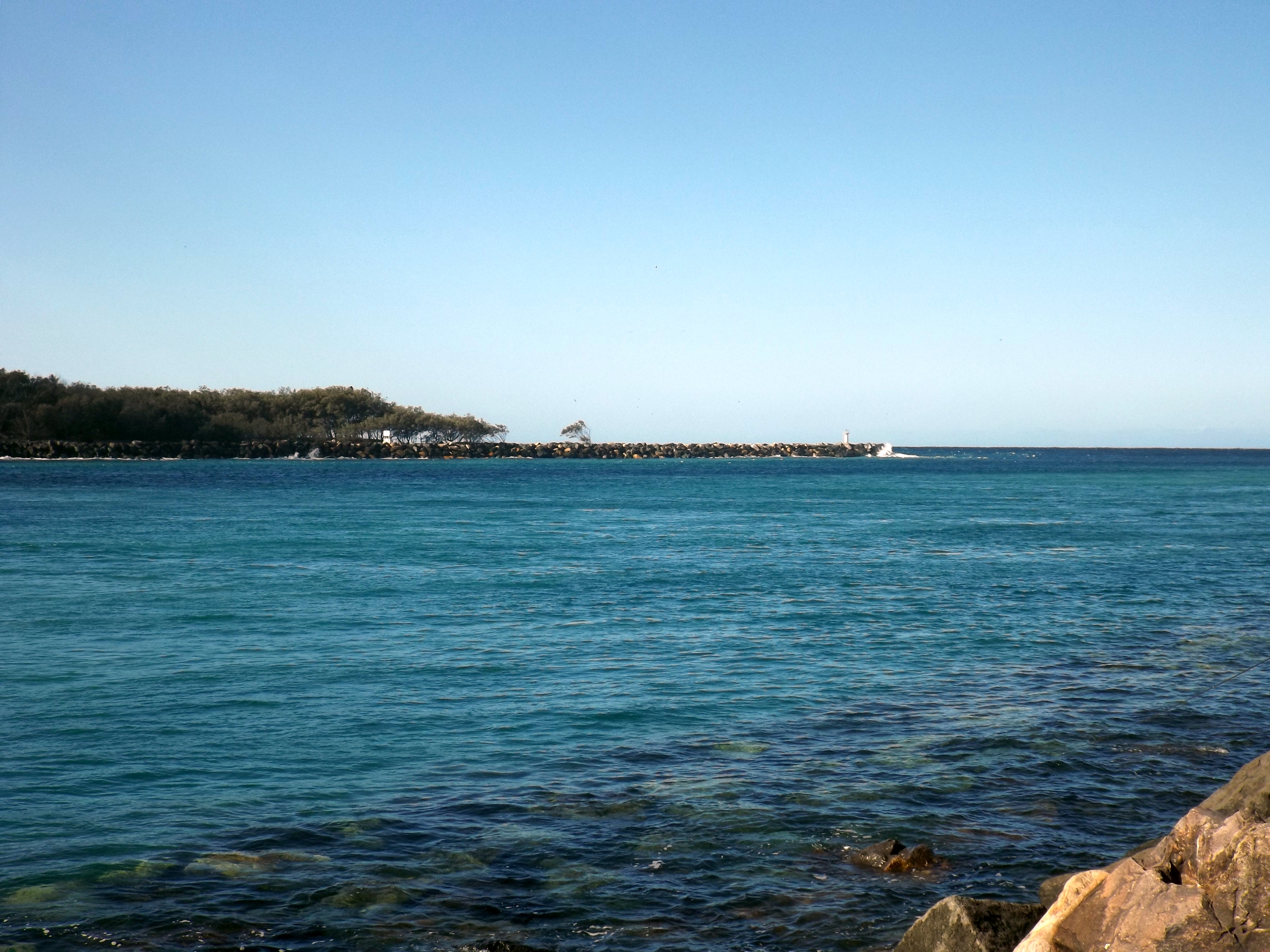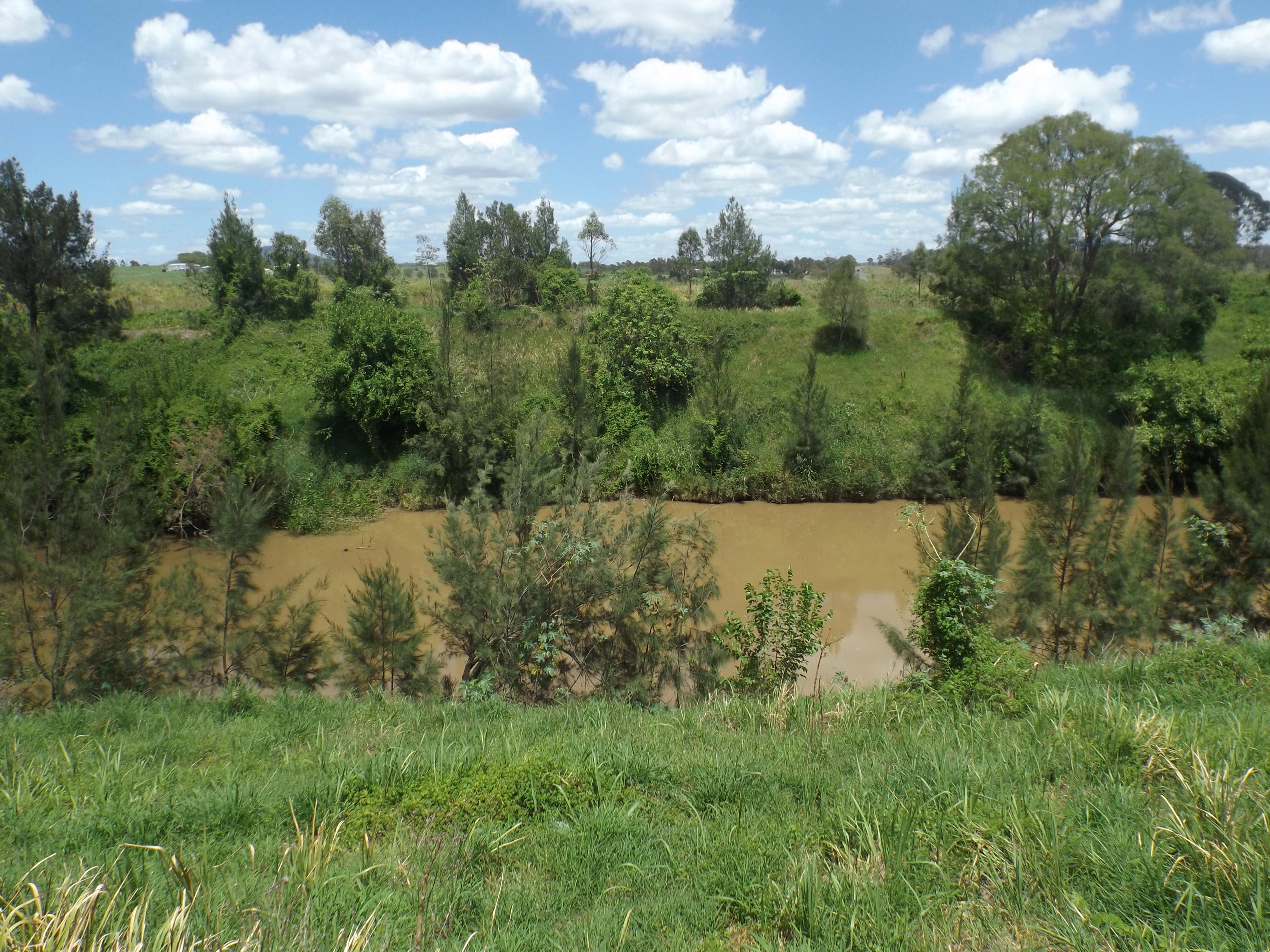|
Jumpinpin Channel
The Jumpinpin channel also known as The Pin lies between North Stradbroke Island and South Stradbroke Island. It has a fast moving tidal deep water Channel not appropriate for swimming but is popular with beach anglers. The name Jumpinpin is a Yugambeh word meaning Pandanus root. The bar area is shallow for a kilometre or so offshore so current local knowledge is required to safely transit the bar. The area around the Pin is constantly changing with sand being deposited in one place after being moved by currents from another area. Just recently the mouth of Swan Bay was moved several hundred metres seaward creating an entirely new boating area. The area is not really suitable for swimming as big tides and fast currents are the norm. Inland from the bar the Pin area consists of mangroves and mud banks, constantly being built up and then being washed away. In recent years Rat Island, The Mud Clump and Squire Island have disappeared. Formation A channel in the general are ... [...More Info...] [...Related Items...] OR: [Wikipedia] [Google] [Baidu] |
North Stradbroke Island
North Stradbroke Island ( Jandai: ''Minjerribah''), colloquially ''Straddie'' or ''North Straddie'', is an island that lies within Moreton Bay in the Australian state of Queensland, southeast of the centre of Brisbane. Originally there was only one Stradbroke Island but in 1896 it split into North Stradbroke Island and South Stradbroke Island separated by the Jumpinpin Channel. The Quandamooka people are the traditional owners of North Stradbroke island. The island is divided into four localities: Dunwich, Amity and Point Lookout are small localities centred on the towns of the same name, while the remainder of the island is in the locality of North Stradbroke Island. All the localities are within the City of Redland. At , it is the second largest sand island in the world. On the island there are three small towns, a number of lakes and beaches along most of the seaward coastline with rocky outcrops at Point Lookout. An Aboriginal presence on the island has been lon ... [...More Info...] [...Related Items...] OR: [Wikipedia] [Google] [Baidu] |
Sparidae
The Sparidae are a family of fish in the order Perciformes, commonly called sea breams and porgies. The sheepshead, scup, and red seabream are species in this family. Most sparids are deep-bodied compressed fish with a small mouth separated by a broad space from the eye, a single dorsal fin with strong spines and soft rays, a short anal fin, long pointed pectoral fins and rather large firmly attached scales. They are found in shallow temperate and tropical waters and are bottom-dwelling carnivores. There are hermaphrodites in the Sparidae. Protogyny and protandry appear sporadically through this lineage of fish. Simultaneous hermaphrodites and bi-directional hermaphrodites do not appear as much since Sparidae are found in shallower waters. Species of fish that express a hermaphroditic condition usually "lack a genetic hardwire", therefore ecological factors play a role in sex determination. Most species possess grinding, molar-like teeth. Eating the head is known to cause hal ... [...More Info...] [...Related Items...] OR: [Wikipedia] [Google] [Baidu] |
Channels Of Australia
Channel, channels, channeling, etc., may refer to: Geography * Channel (geography), in physical geography, a landform consisting of the outline (banks) of the path of a narrow body of water. Australia * Channel Country, region of outback Australia in Queensland and partly in South Australia, Northern Territory and New South Wales. * Channel Highway, a regional highway in Tasmania, Australia. Europe * Channel Islands, an archipelago in the English Channel, off the French coast of Normandy * Channel Tunnel or Chunnel, a rail tunnel underneath the English Channel * English Channel, called simply "The Channel", the part of the Atlantic Ocean that separates Great Britain from northern France North America * Channel Islands of California, a chain of eight islands located in the Pacific Ocean off the coast of Southern California, United States * Channel Lake, Illinois, a census-designated place in Lake County, Illinois, United States * Channels State Forest, a state forest in Virginia ... [...More Info...] [...Related Items...] OR: [Wikipedia] [Google] [Baidu] |
Moreton Bay
Moreton Bay is a bay located on the eastern coast of Australia from central Brisbane, Queensland. It is one of Queensland's most important coastal resources. The waters of Moreton Bay are a popular destination for recreational anglers and are used by commercial operators who provide seafood to market. The Port of Brisbane coordinates large traffic along the shipping channel which crosses the northern section of the bay. The bay serves as a safe approach to the airport and reduces noise pollution over the city to the west of the runway. A number of barge, ferry and water-taxi services also travel over the bay. Moreton Bay was the site of conflict between the Quandamooka people and early European settlers. It contains environmentally significant habitats and large areas of sandbanks. The bay is the only place in Australia where dugong gather into herds. Many parts of the mainland foreshore and southern islands are settled. The waters of Moreton Bay are relatively calm, bein ... [...More Info...] [...Related Items...] OR: [Wikipedia] [Google] [Baidu] |
Gold Coast Seaway
The Gold Coast Seaway or Southport Seaway is the main navigation entrance from the Pacific Ocean into the Gold Coast Broadwater and southern Moreton Bay and is one of Australia's most significant coastal engineering projects. It is located at the northern end of the Southport Spit where the Nerang River enters the Pacific Ocean. The channel was constructed between 1984 and 1986, primarily to facilitate the safe passage of sea-faring vessels. The passage was previously known as the Southport Bar. The mouth of the Nerang River was once located further south in Broadbeach. The main driving force for this movement is the northward drift of sand along the coast. Before the bypass system was implemented the mouth of the Nerang River moved northwards at a rate of 60 metres per year. This northward drift was responsible for the unstable and shifting conditions of the bar, which made crossing it so hazardous for small boats. The southern training wall of the Gold Coast Seaway ... [...More Info...] [...Related Items...] OR: [Wikipedia] [Google] [Baidu] |
Mulloway
''Argyrosomus japonicus'' is a silvery to bronze-green colored fish, a member of the family Sciaenidae, which may grow up to in length. It is known as Japanese meagre ( FAO), mulloway or jewfish on the east coast of Australia, butterfish in South Australia, kingfish or river kingfish in Western Australia, and dusky/squaretail kob, dusky salmon, salmon or kabeljou in South Africa, Ô-nibe (大鮸, オオニベ) in Japan. The name jewfish refers to its large otoliths, which are prized as "jewels" by some fishers. Description ''Argyrosomus japonicus'' is a large, slender fish which can grow to . It has a copper-colored head and is silvery with a bronze-green dorsal surface and paler belly. It has a row of distinctive white spots running along the lateral line. The caudal fin is angular in juveniles but becomes more rounded in larger fish. Distribution and habitat ''Argyrosomus japonicus'' has an Indo-Pacific distribution occurring in coastal waters surrounding Australia, Africa, I ... [...More Info...] [...Related Items...] OR: [Wikipedia] [Google] [Baidu] |
Trevally
The Carangidae are a family of ray-finned fish which includes the jacks, pompanos, jack mackerels, runners, and scads. It is the largest of the six families included within the order Carangiformes. Some authorities classify it as the only family within that order but molecular and anatomical studies indicate that there is a close relationship between this family and the five former Perciform families which make up the Carangiformes. They are marine fishes found in the Atlantic, Indian and Pacific Oceans. Most species are fast-swimming predatory fishes that hunt in the waters above reefs and in the open sea; some dig in the sea floor for invertebrates. The largest fish in the family, the greater amberjack, ''Seriola dumerili'', grows up to 2 m in length; most fish in the family reach a maximum length of 25–100 cm. The family contains many important commercial and game fish, notably the Pacific jack mackerel, ''Trachurus symmetricus'', and the other jack mackerels ... [...More Info...] [...Related Items...] OR: [Wikipedia] [Google] [Baidu] |
Tailor (fish)
The bluefish (''Pomatomus saltatrix'') is the only extant species of the family Pomatomidae. It is a marine pelagic fish found around the world in temperate and subtropical waters, except for the northern Pacific Ocean. Bluefish are known as tailor in Australia and New Zealand, elf and shad in South Africa. It is a popular gamefish and food fish. The bluefish is a moderately proportioned fish, with a broad, forked tail. The spiny first dorsal fin is normally folded back in a groove, as are its pectoral fins. Coloration is a grayish blue-green dorsally, fading to white on the lower sides and belly. Its single row of teeth in each jaw is uniform in size, knife-edged, and sharp. Bluefish commonly range in size from seven-inch (18-cm) "snappers" to much larger, sometimes weighing as much as 40 lb (18 kg), though fish heavier than 20 lb (9 kg) are exceptional. Systematics The bluefish is the only extant species now included in the family Pomatomidae. At one t ... [...More Info...] [...Related Items...] OR: [Wikipedia] [Google] [Baidu] |
Luderick
The parore (''Girella tricuspidata'') also known as luderick, black bream or blackfish is a species of marine ray-finned fish, a sea chub from the family Kyphosidae which is found in the southwestern Pacific Ocean off Australia and New Zealand. Parore or paraore is the common name in New Zealand but in Australia luderick is preferred. Description The parore has a moderately deep, compressed, oval shaped body with a thin caudal peduncle, It has a small head which has a slightly convex forehead, and small eyes. The mouth is small and does not extend as far as the eye. The jaws have an outer row of overlapping, flattened, tricuspid teeth beside a wide band of teeth of similar shape but which are tiny. Much of the body is covered im moderately small ctenoid scales and there is an arched lateral line, made up of 48-51 pored scales, which is parallel to the dorsal profile. It has a continuous dorsal fin which has no demarcation between its spiny and rayed parts. The spiny part has 1 ... [...More Info...] [...Related Items...] OR: [Wikipedia] [Google] [Baidu] |
Whiting (fish)
A number of Actinopterygiian fish have been given the common name whiting. Gadiformes (cod-like) * The fish originally known by the name "whiting" in English is '' Merlangius merlangus'', in the family Gadidae. This species inhabits the eastern Atlantic Ocean and the Mediterranean Sea, as well as the North Sea on the East Coast of Britain. In the United States, it is commonly known as the English whiting. * In Canada, it is used for the Alaska pollock, ''Theragra chalcogramma''. * In the Southern Ocean, it is used for the southern blue whiting. * In the US, the name whiting on its own is often used for various species of hake in the genus '' Merluccius''. Sciaenidae * Species '' Menticirrhus americanus'' (also known as the Carolina whiting, king whiting, sea mullet, southern kingcroaker, and southern kingfish) found along the Atlantic and Gulf Coasts of the United States. Smelt-whitings * In Australia, India, and throughout the Indo-Pacific, the name whiting is used for fish i ... [...More Info...] [...Related Items...] OR: [Wikipedia] [Google] [Baidu] |
Flathead (fish)
A flathead is one of a number of small to medium fish species with notably flat heads, distributed in membership across various genera of the family Platycephalidae. Many species are found in the Indo-Pacific, especially most parts of Australia where they are popular sport and table fish. They inhabit estuaries and the open ocean. Flathead can grow at least 3m in length and 18 kilograms in weight, with dusky flathead being the biggest, although fish this size are seldom caught. Anatomy and morphology Flathead are notable for their unusual body shape, which their hunting strategy is based upon. Flathead are dorsally compressed, meaning their body is wide but flattened and very low in height. Both eyes are on the top of the flattened head, giving excellent binocular vision to attack overhead prey. The effect is somewhat similar to flounders. In contrast to flounder, however, flathead are much more elongated, the tail remains vertical, and the mouth is large, wide and symmet ... [...More Info...] [...Related Items...] OR: [Wikipedia] [Google] [Baidu] |
Logan River
The Logan River ( Yugambeh: ''Dugulumba'') is a perennial river located in the Scenic Rim, Logan and Gold Coast local government areas of the South East region of Queensland, Australia. The -long river is one of the dominant waterways in South East Queensland that drains the southern ranges of the Scenic Rim and empties into Moreton Bay after navigating the City of Logan, a major suburban centre located south of Brisbane. The catchment is dominated by urban and agricultural land use. Near the river mouth are mangrove forests and a number of aquaculture farms. Course and features The river rises below Mount Ernest on the southern slopes of the Scenic Rim, part of the Great Dividing Range and forms in the Mount Barney National Park, near the Queensland New South Wales border, below Mount Lindesay. The river flows generally north by northeast, joined by eleven minor tributaries, before heading east and eventually emptying into Moreton Bay. Its principal tributaries a ... [...More Info...] [...Related Items...] OR: [Wikipedia] [Google] [Baidu] |
.jpg)





